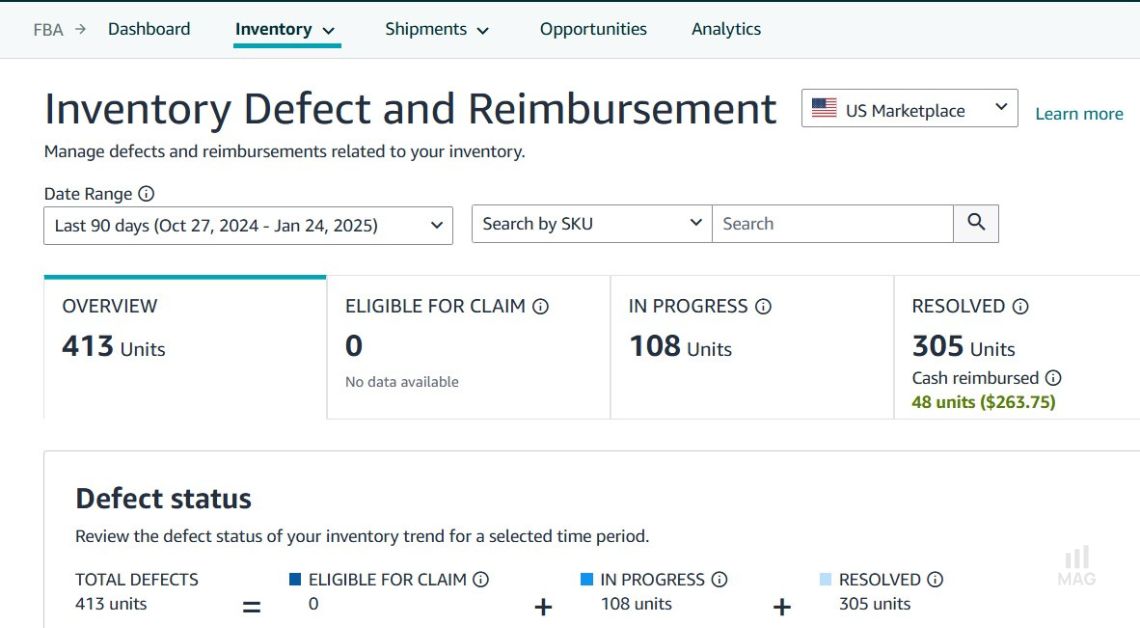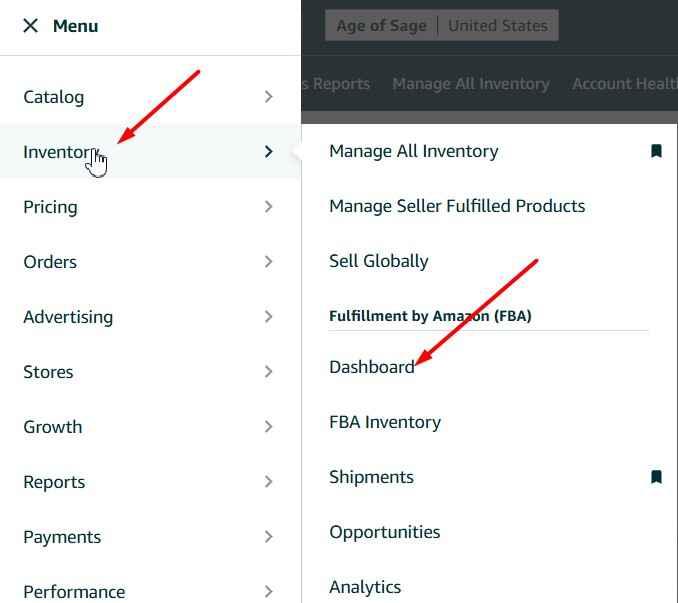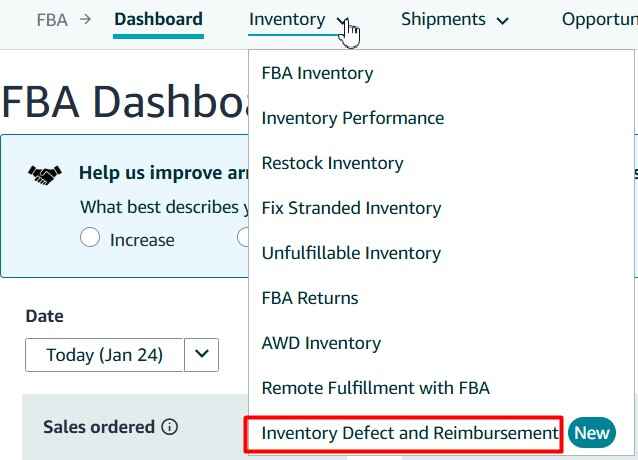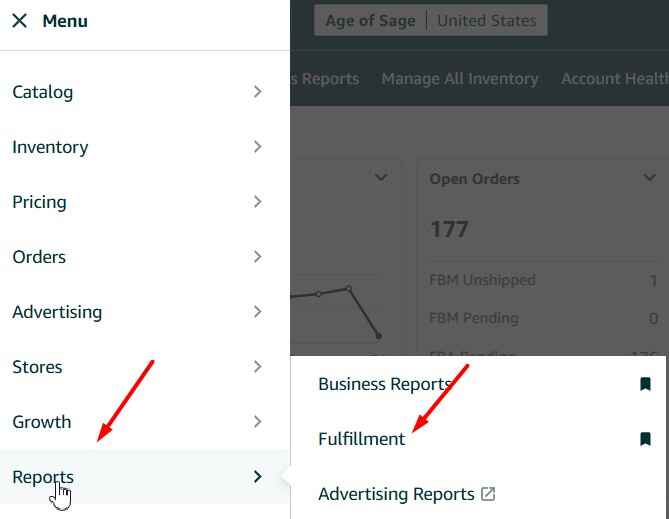
Amazon launched new Inventory Defect and Reimbursement portal, providing FBA sellers with a centralized platform to manage inventory-related defects, track reimbursements, and gain insights into inventory health.
Managing Fulfillment by Amazon (FBA) inventory has long been a challenge for sellers, especially when dealing with defects and reimbursements. Many sellers struggle with transparency and efficiency, leading to wasted time and unclaimed reimbursements.
Amazon has launched the new Inventory Defect and Reimbursement Portal, offering a centralized solution to manage warehouse defects, damage, and customer returns. Let look at the insights on how you can best use this tool.
What Is the Inventory Defect and Reimbursement Portal?
A January 21, 2025 Amazon Seller Central news article featured the new Inventory defect and Reimbursement portal, a centralized dashboard for managing all FBA inventory-related defects and Amazon reimbursements. Sellers can monitor defects like warehouse damage and customer returns, view detailed defect information, and identify reimbursable opportunities—all in one place.
How to access the portal
Log in to Seller Central, then navigate to the IDR Portal using one of these options:
- From the Inventory menu, go to FBA Dashboard > Inventory > Defect and Reimbursement.
Portal key features
The Inventory Defect and Reimbursement Portal simplifies defect management by addressing common seller pain points:
- Struggling with incomplete data? Get complete visibility into defect types, statuses, and resolutions.
- Lost track of claims? Access detailed defect information, including reasons, actions taken, and creation dates.
- Missing reimbursements? Identify opportunities with a comprehensive view across multiple reports and policy checks.
- Confused by recurring issues? Gain insights into defect frequency and resolution rationales to prevent future problems.
The portal, however, excludes defects related to inbound shipments, removals, and warehouse disposals.
Navigating the portal
View all defects categorized by their current status: Eligible for Claim, In Progress, or Resolved. Use global filters such as date range, product search by SKU or ASIN, and event type to customize defect research.
Status categories
- Eligible for Claim
Quickly identify and prioritize defects that require action, including warehouse damage, customer returns, or other defect types.
- In Progress
See defects that Amazon is currently reviewing, giving you visibility without needing to take action until resolution.
- Resolved
Access detailed information on resolved defects, including reimbursement status and the reasoning behind each resolution.
Best practices when using the portal
- Filter by defect type (e.g., warehouse damage, customer returns) to focus on the most impactful issues.
- Utilize the Defect Status Trend graph to prioritize defects that are nearing the end of their claim eligibility.
Why the New Inventory Defect and Reimbursement Portal Matters to Sellers
Amazon's New Reimbursement Policy Raises Seller Concerns
Joel MacPherson, co-founder of TrueOps"On average, reimbursements from lost or damaged inventory comprise 1% to 3% of a seller’s annual revenue"
It was featured in a Modern Retail article that Amazon’s updated reimbursement policy, effective March 10, 2025, limits payouts for lost or damaged FBA inventory to product manufacturing costs rather than full retail value.
Sellers now face two options: rely on Amazon’s estimates, which some fear may undervalue their products, or submit their manufacturing costs, raising concerns about data privacy.
While Amazon pledged no new fees in 2025, many sellers view this policy shift as a backdoor fee increase, impacting their earnings and creating widespread unease.
Amazon’s recent shift in FBA reimbursement policy discussed in the video above, emphasizing manufacturer costs, creates new challenges for sellers. The portal becomes crucial in this evolving landscape:
By analyzing data and identifying trends, sellers can proactively address inventory issues and minimize future losses. The portal simplifies the process, allowing for efficient tracking and management of reimbursement claims.
Keeping Order Defect Rate Low
The Order Defect Rate (ODR) measures the percentage of orders with issues, like negative feedback, A-to-Z claims, or chargebacks, over 60 days. Sellers must keep ODR below 1% to avoid losing the Buy Box or account deactivation.
Amazon’s Inventory Defect and Reimbursement Portal helps sellers manage ODR by:
- Tracking defects and their causes.
- Breaking down metrics for targeted action.
- Simplifying claim resolution to address issues quickly.
Actionable Insights for Amazon Sellers to Minimize Profit Loss
1. Prioritize Defects Eligible for Claims
For Amazon sellers, knowing which products are eligible for claims is critical to optimizing operations and maximizing reimbursements.
The Eligible for Claim section of the portal provides a quick and clear view of defects that require action, including warehouse damage, customer returns, or other defect types.
Regularly review the Eligible for Claim section to identify issues requiring immediate action, such as warehouse damage or customer returns. Here’s a video that can guide sellers on how to win claims.
2. Track the Progress of Claims Under Review
Use the In Progress section to monitor claims Amazon is actively reviewing. This provides visibility into pending resolutions without duplicating efforts.
3. Leverage the Resolved Section for Insights
Analyze resolved claims to understand reimbursement trends and reasons behind decisions. Use this data to address recurring issues, such as packaging improvements for commonly damaged items.
4. Utilize Filters for Targeted Analysis
Filter defects by type, SKU, or ASIN to identify which products are most frequently affected and why. Investigate trends using the Defect Status Trend graph to act on defects nearing the end of their claim eligibility.
5. Focus on High-Impact Claims
Use the defect type bar chart to identify the most frequent issues. Prioritize these claims to maximize reimbursements and reduce the financial impact on your business.
6. Implement Preventive Measures
Use the portal’s insights to address defects’ root causes, such as improving packaging for fragile items or streamlining warehouse handling. Collaborate with suppliers and manufacturers to reduce defect rates and avoid similar issues in the future.
Proactively Dealing With the Challenges
1. Challenge: Time-Intensive Claim Management
Regularly reviewing the Eligible for Claim section and tracking claim progress can be overwhelming, especially for sellers with large inventories.
Solution:
Set up a routine schedule to review claims and monitor progress. Work with an Amazon agency to manage claim submissions and follow-ups efficiently.
2. Challenge: Identifying Trends and Insights
Analyzing resolved claims and filtering defects to uncover trends requires technical know-how and time.
Solution:
Use advanced tools like Helium 10 or consult with an Amazon agency to provide actionable insights to help reduce recurring defects.
3. Challenge: Managing Frequent Defects
High-volume defects can strain operations, making it difficult to address root causes promptly.
Solutions:
- Regularly inspect suppliers to ensure they adhere to quality standards and manufacturing processes.
- Take corrective actions to address root causes, such as improving manufacturing processes, refining packaging materials, or optimizing shipping procedures.
- Maintain detailed records of all defects, including photographs, videos, and supporting documentation, to facilitate reimbursement.










